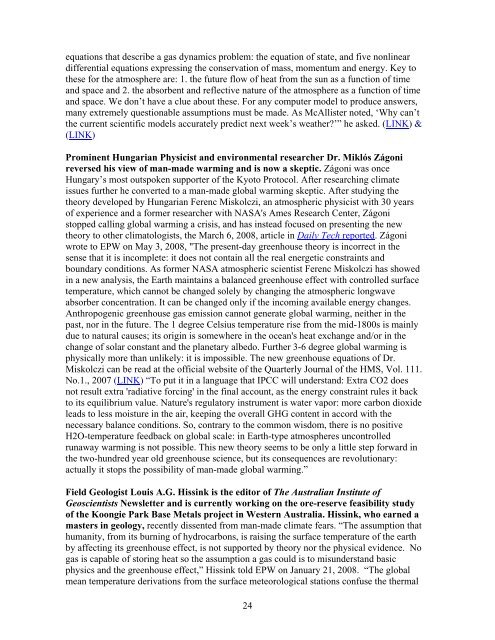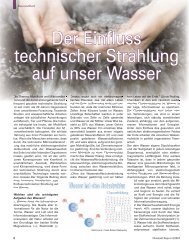U. S. Senate Minority Report: - Klimaforschung
U. S. Senate Minority Report: - Klimaforschung
U. S. Senate Minority Report: - Klimaforschung
Create successful ePaper yourself
Turn your PDF publications into a flip-book with our unique Google optimized e-Paper software.
equations that describe a gas dynamics problem: the equation of state, and five nonlinear<br />
differential equations expressing the conservation of mass, momentum and energy. Key to<br />
these for the atmosphere are: 1. the future flow of heat from the sun as a function of time<br />
and space and 2. the absorbent and reflective nature of the atmosphere as a function of time<br />
and space. We don’t have a clue about these. For any computer model to produce answers,<br />
many extremely questionable assumptions must be made. As McAllister noted, ‘Why can’t<br />
the current scientific models accurately predict next week’s weather?’” he asked. (LINK) &<br />
(LINK)<br />
Prominent Hungarian Physicist and environmental researcher Dr. Miklós Zágoni<br />
reversed his view of man-made warming and is now a skeptic. Zágoni was once<br />
Hungary’s most outspoken supporter of the Kyoto Protocol. After researching climate<br />
issues further he converted to a man-made global warming skeptic. After studying the<br />
theory developed by Hungarian Ferenc Miskolczi, an atmospheric physicist with 30 years<br />
of experience and a former researcher with NASA's Ames Research Center, Zágoni<br />
stopped calling global warming a crisis, and has instead focused on presenting the new<br />
theory to other climatologists, the March 6, 2008, article in Daily Tech reported. Zágoni<br />
wrote to EPW on May 3, 2008, "The present-day greenhouse theory is incorrect in the<br />
sense that it is incomplete: it does not contain all the real energetic constraints and<br />
boundary conditions. As former NASA atmospheric scientist Ferenc Miskolczi has showed<br />
in a new analysis, the Earth maintains a balanced greenhouse effect with controlled surface<br />
temperature, which cannot be changed solely by changing the atmospheric longwave<br />
absorber concentration. It can be changed only if the incoming available energy changes.<br />
Anthropogenic greenhouse gas emission cannot generate global warming, neither in the<br />
past, nor in the future. The 1 degree Celsius temperature rise from the mid-1800s is mainly<br />
due to natural causes; its origin is somewhere in the ocean's heat exchange and/or in the<br />
change of solar constant and the planetary albedo. Further 3-6 degree global warming is<br />
physically more than unlikely: it is impossible. The new greenhouse equations of Dr.<br />
Miskolczi can be read at the official website of the Quarterly Journal of the HMS, Vol. 111.<br />
No.1., 2007 (LINK) “To put it in a language that IPCC will understand: Extra CO2 does<br />
not result extra 'radiative forcing' in the final account, as the energy constraint rules it back<br />
to its equilibrium value. Nature's regulatory instrument is water vapor: more carbon dioxide<br />
leads to less moisture in the air, keeping the overall GHG content in accord with the<br />
necessary balance conditions. So, contrary to the common wisdom, there is no positive<br />
H2O-temperature feedback on global scale: in Earth-type atmospheres uncontrolled<br />
runaway warming is not possible. This new theory seems to be only a little step forward in<br />
the two-hundred year old greenhouse science, but its consequences are revolutionary:<br />
actually it stops the possibility of man-made global warming.”<br />
Field Geologist Louis A.G. Hissink is the editor of The Australian Institute of<br />
Geoscientists Newsletter and is currently working on the ore-reserve feasibility study<br />
of the Koongie Park Base Metals project in Western Australia. Hissink, who earned a<br />
masters in geology, recently dissented from man-made climate fears. “The assumption that<br />
humanity, from its burning of hydrocarbons, is raising the surface temperature of the earth<br />
by affecting its greenhouse effect, is not supported by theory nor the physical evidence. No<br />
gas is capable of storing heat so the assumption a gas could is to misunderstand basic<br />
physics and the greenhouse effect,” Hissink told EPW on January 21, 2008. “The global<br />
mean temperature derivations from the surface meteorological stations confuse the thermal<br />
24





